Francisco Neto has his team primed for their first appearance at the World Cup.
A Selecção das Quinas are not only a domestic-heavy squad, but most of the players are teammates at Benfica. The understanding between the teammates has grown steadily in recent years and they’re playing some of the most attractive football among the teams in the tournament.
Earning their first World Cup berth through a three-stage playoff was a massive step in the right direction for the Portuguese. Coming off of their first appearance in the Euros, the Portuguese women are the toast of the country. Even Cristiano Ronaldo joined in on the congratulatory remarks. The Real Madrid, Manchester United, Juventus and Sporting CP legend was among the ranks of famous Portuguese to congratulate the team on the historic achievement and celebrate their success through social media.
What makes Neto’s team so special? This tactical analysis will give a blend of data visualisations and tactical images to show why the group favourites, the USA and the Netherlands, can’t write off the Portuguese. The scout report shows why.
Predicted starting XI
This Portugal team is more identifiable by their game model than a specific system. In the past couple of years, they have alternated between a 4-4-2 with the diamond midfield and a 4-3-3. In their most recent matches, the 4-3-3 has been more prevalent. That said, when Portugal plays top opponents, they tend to play more conservatively in a 4-4-2. This is especially the case when the opponent plays a 4-4-3 and incorporates the six in a deeper position in the attacking phases while pushing the #8 and #10 higher up the pitch.
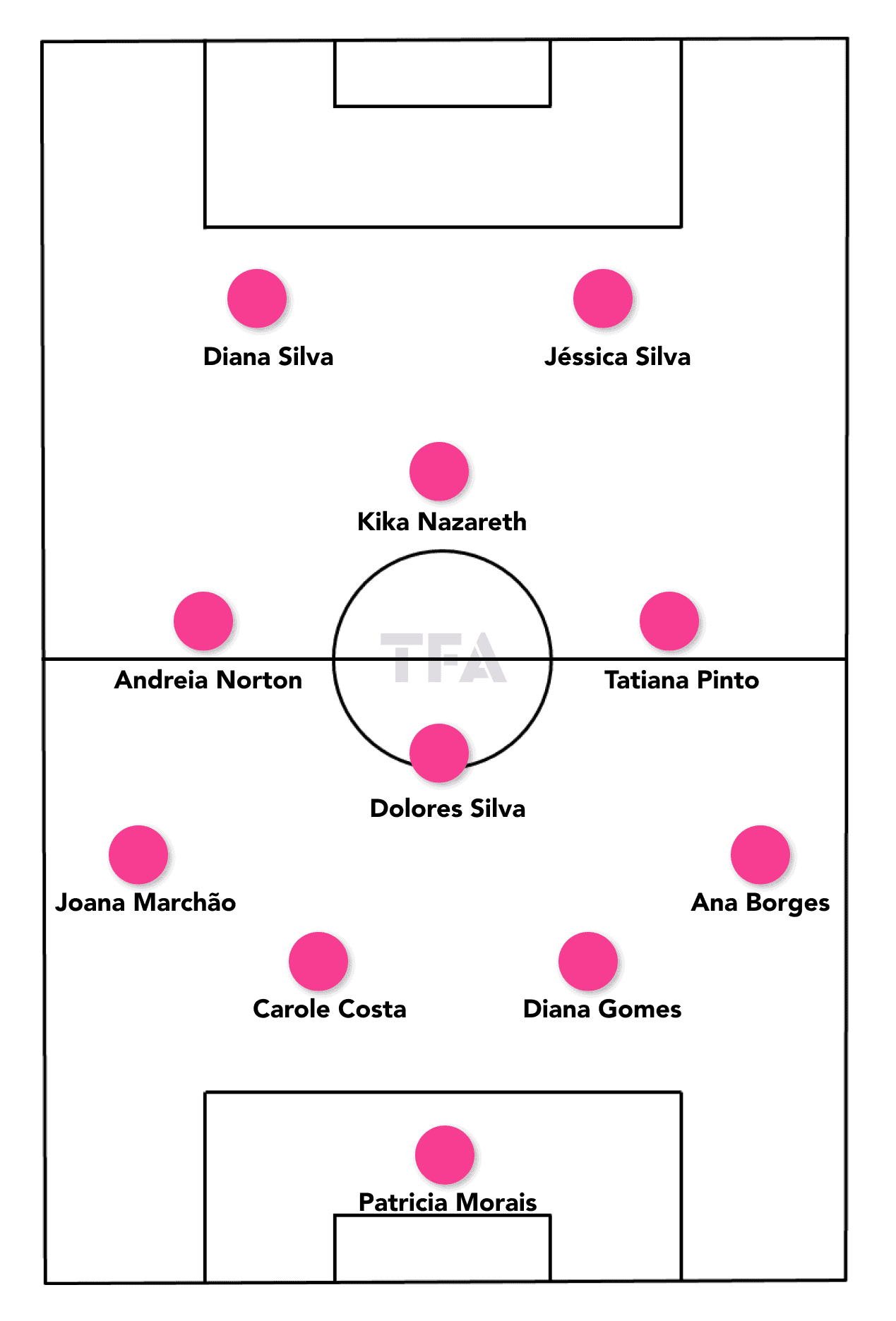
For this analysis, we’ll assume Neto will lean more heavily on a 4-4-2 with the diamond midfield, but don’t be surprised to see the 4-3-3. We may even see both formations in the same game.
Patrícia Morais is the likeliest to start in goal, using her passing range to help direct Portugal’s build-out. In front of her, she’ll have her stalwart centre-backs, Carole Costa and Diana Gomes. Ana Borges, typically a wide forward, is likely to play outside-back in the tournament with Joana Marchão on the other side.
Look for a midfield with Dolores Silva at the bottom of the diamond and supported by Tatiana Pinto to her right. Andreia Norton will use her attacking wizardry on the left while Kika Nazareth is likeliest to start at the #10. That leaves Jéssica Silva and Diana Silva up top. With their speed, the two will look to run in behind opponents while creating spaces underneath them for their midfielders to attack.
Looking at their age profile, there are some key players who are likely in their last World Cup cycle. Costa, Borges and Dolores Silva immediately come to mind. Other than those few players, this is a fairly young Portuguese team with a nice blend of up-and-coming youngsters and women hitting the peaks of their careers.
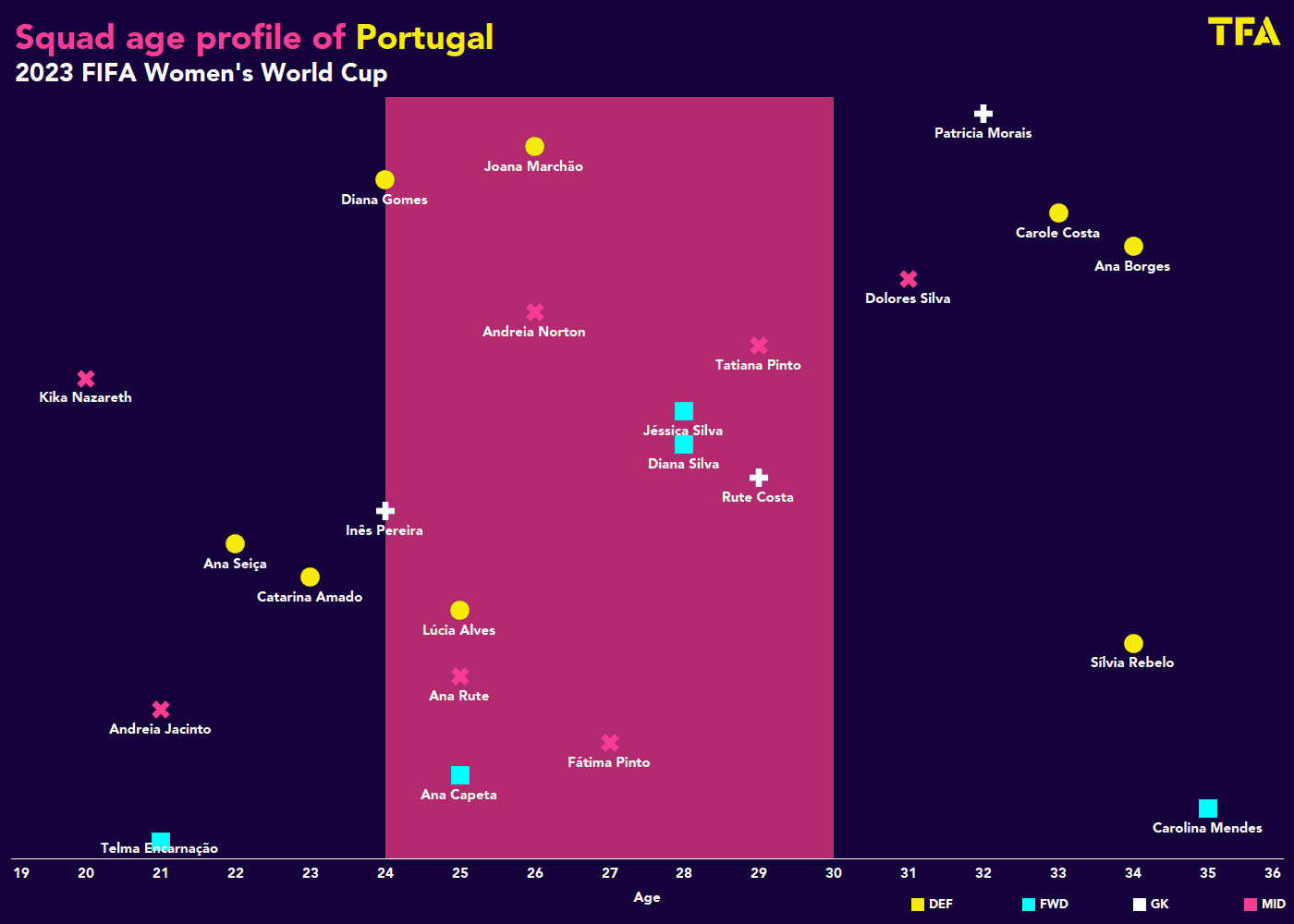
From a statistical standpoint, it’s the perfect blend for tournament play. It’s a group that experienced their first major tournament just a year ago and many of the players are carryovers from that group. You’ll recall they had a very difficult group at the Euros, which included a 3-2 loss at the hands of the Netherlands. Portugal surprised many, exceeding expectations with the draw against Switzerland and a narrow defeat against the Netherlands. They’ll look to take the next step at the World Cup despite another very difficult group.
Attacking phase
Much of Portugal’s greatest strides in recent years have come through their attacking output. At the previous Euros, it was their defence that kept them in games and helped them qualify for the tournament. This time around, there’s far more balance in the squad. It’s a team that can not only keep you off the scoreboard, but their style of play creates their fair share of goal-scoring opportunities.
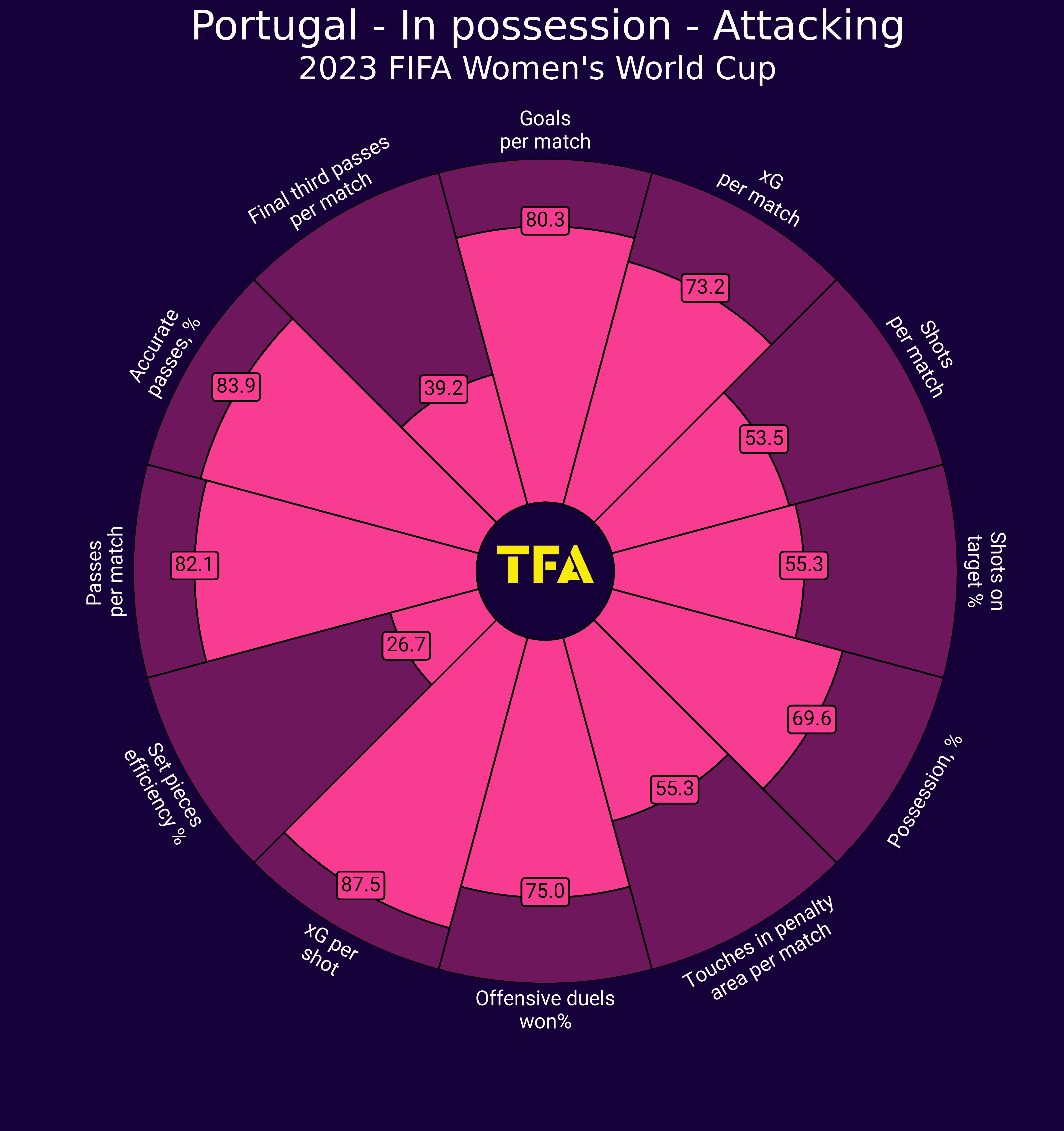
This is a team that likes to have the ball at their feet. They are very intelligent in possession, showing excellent positional understanding and awareness of where their teammates are. Playing their club seasons largely in the Portuguese League and primarily at Benfica has greatly helped their attacking cohesion.
Looking at the attacking chart, this is a possession-dominant side that has become a more prolific goal-scoring team. Perhaps the greatest reason for the development is the many ways that they can attack you. They’re not only an excelling passing team, but they also have players up top who are willing to run in behind and they have very good 1v1 ability across the squad.
They can systematically break opponents down with their fluid passing and positional movements, but they’re equally adept at playing directly into the forward line. That’s especially the case against better teams. In their recent match against Japan, when Japan over-committed high up the pitch, Portugal looked to play long into Ana Capeta, winning the first ball and setting it back to their midfield. When playing in a two-forward system, the attacking midfielder is especially the target.
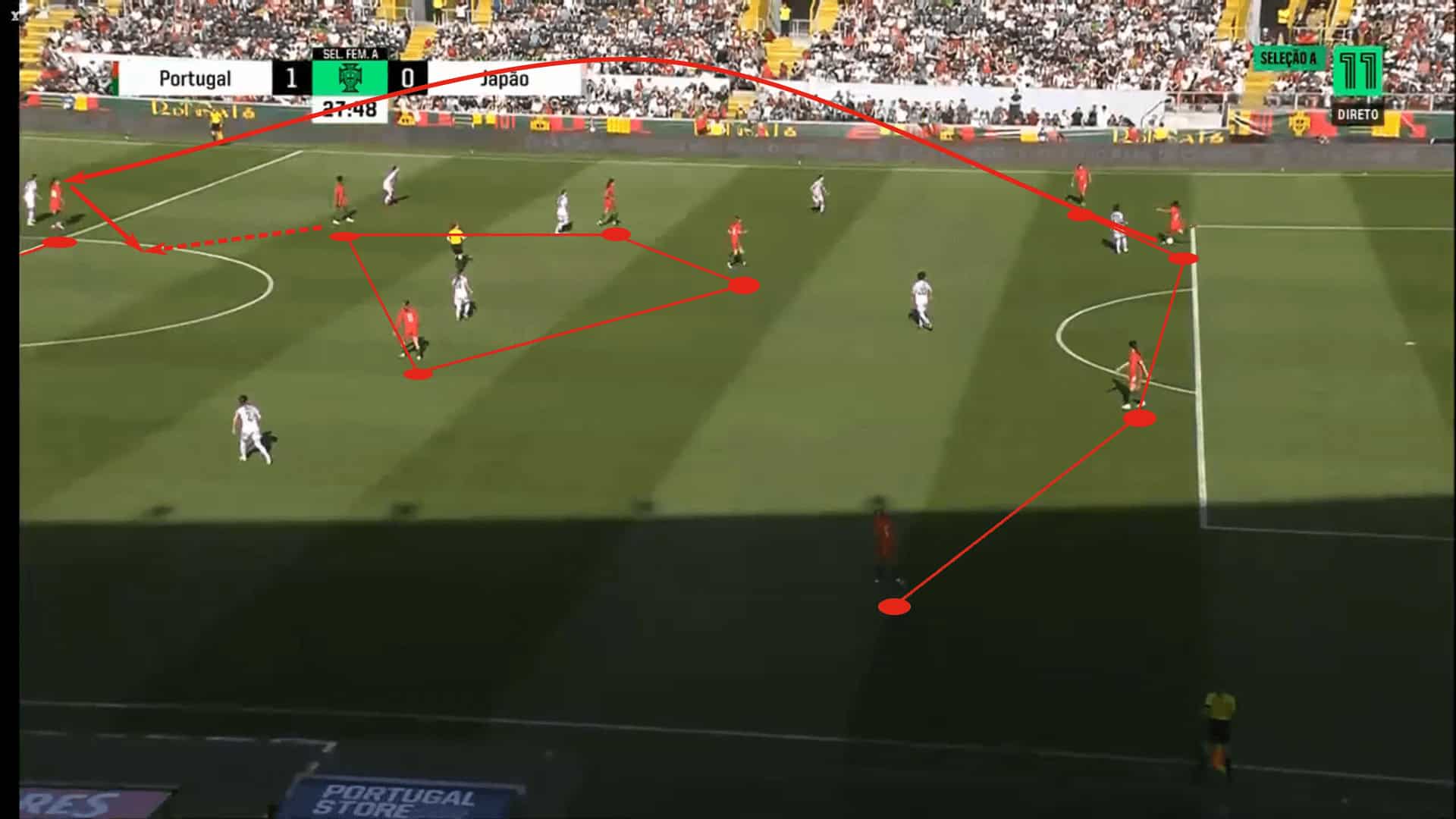
When opponents applied pressure more systematically, as opposed to flying at the backline, Portugal will use central combination play to create space on the wings for progression. Against Wales, a quick little give-and-go beat the first defender and allowed Portugal to get behind her into the wings. They’re very good at finding these 2v1s and using them to spring one of the two players into space.
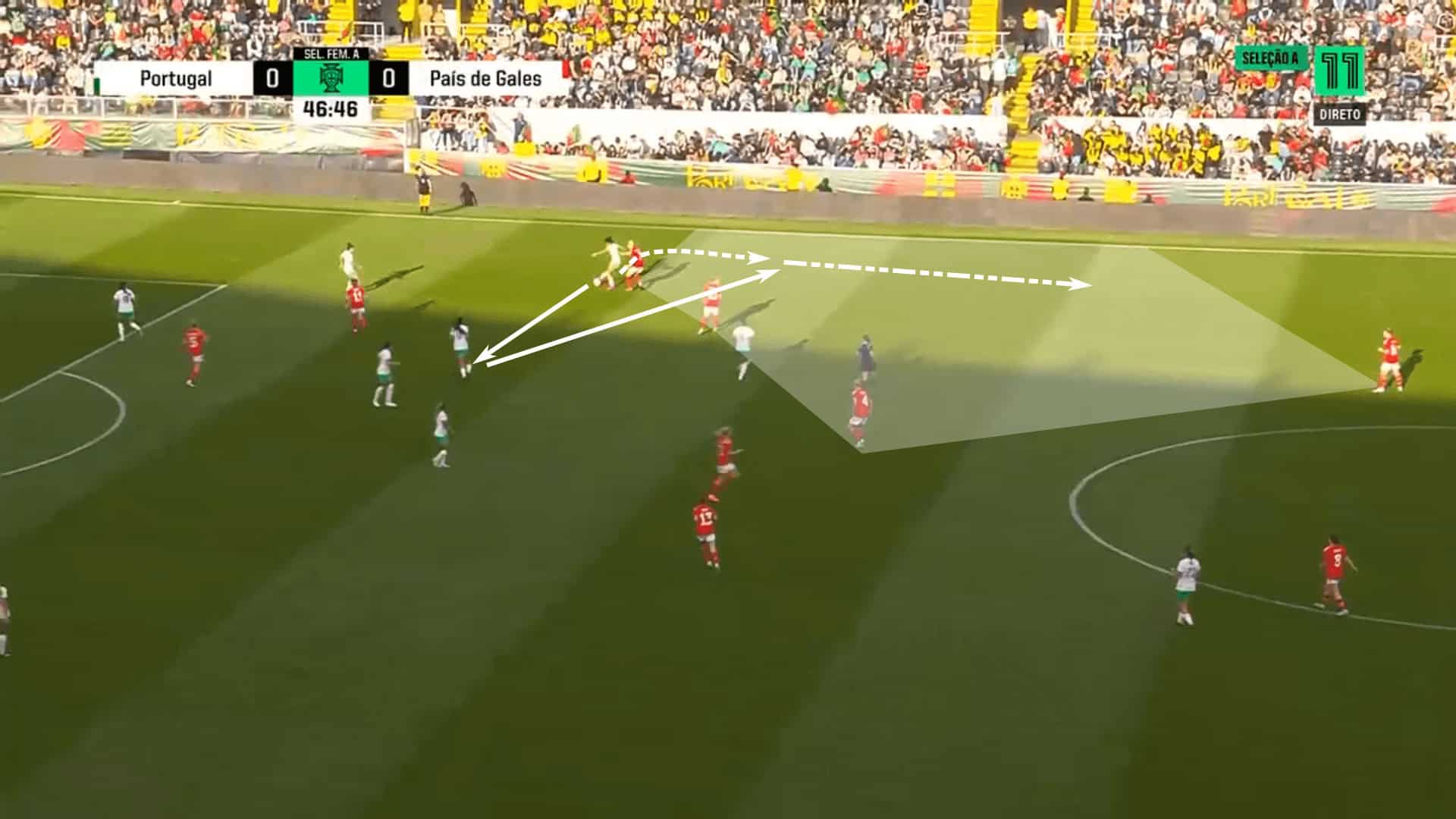
Portugal are very clever in creating numeric superiorities. They’re especially good at creating that advantage centrally to then create space in the wings for the outside-backs and wide forwards to exploit. They’re very good at overloading near the ball to create a positional superiority elsewhere, especially utilising the switch of play to break the opponent’s press and push up the pitch.
When Portugal can get the ball high up the pitch into one of their more advanced midfielders or an outside-back in a high and wide position, the forwards are very active offering runs in behind. If they feature a front three, those runs will often come from the #7 and #11. If they can stretch the backline horizontally, they’ll look to play through to use their pace up top. This through ball against Japan left Portugal 1v1 against the goalkeeper. It was a golden chance to go up two goals against one of the best the women’s game has to offer.
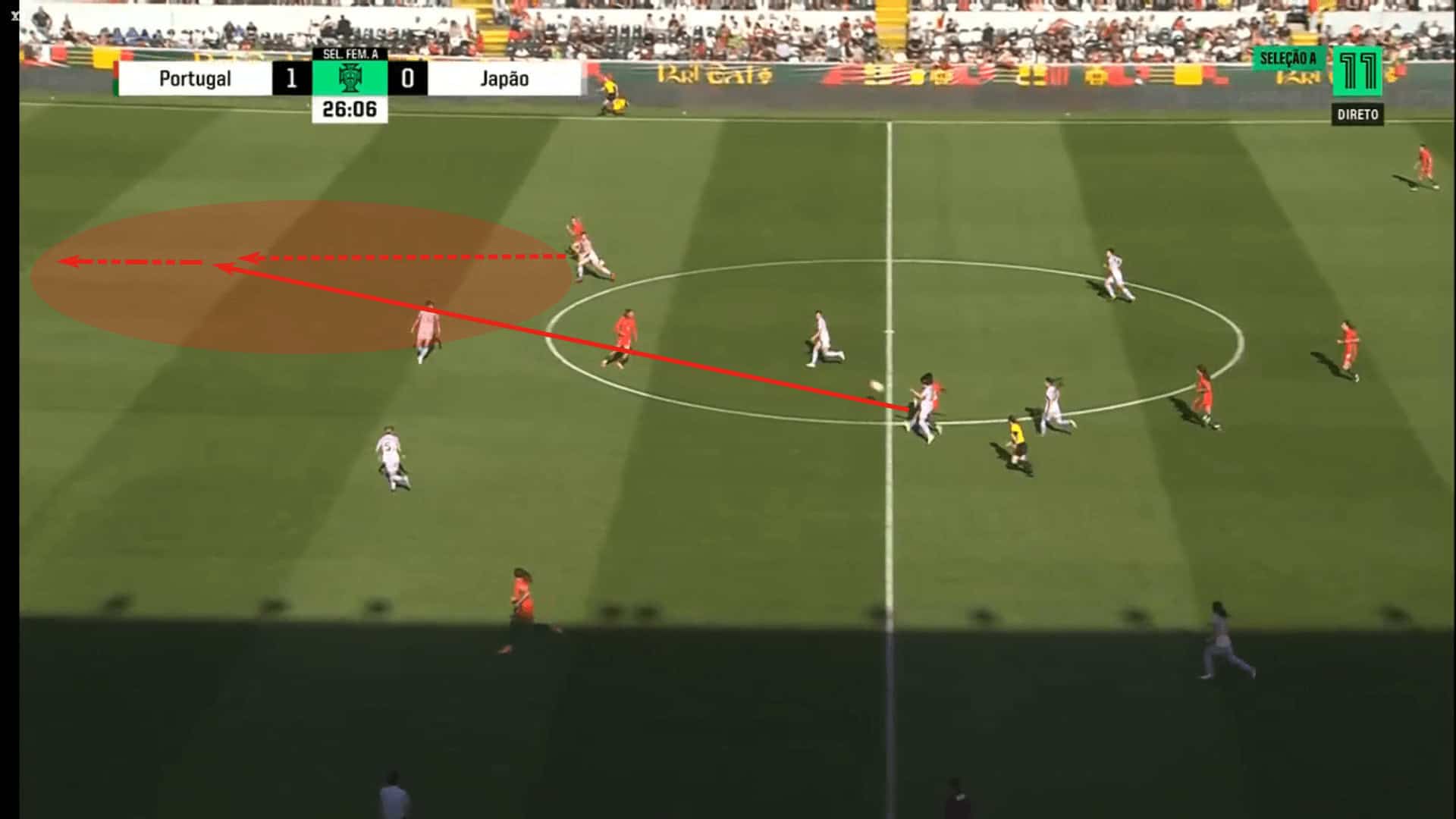
With the two-forward system, Look for the runs to target the 2/4 and 3/5 gaps in the opponent’s backline. This is especially the case when they can push the outside-backs into high and wide positions. The goal is to engage the opponent’s outside-backs, widening the gap between her and the supporting centreback. That’s where the Portuguese forwards will take their position. It’s the starting point for their runs. These passes will often lead them into the half spaces with the hope of entering the box.

If the Portuguese find themselves down a number as they look to attack the box, look for the second forward to try to occupy two defenders while the first, who is receiving the ball, takes up a wider position as happened against Wales. This was their clever way of creating a 1v1 with an opportunity for Telma Encarnação to go to goal. In this instance, the payoff was immediate. Encarnação won the duel and cut inside to unleash her shot, the opening goal of the game from just outside the box.
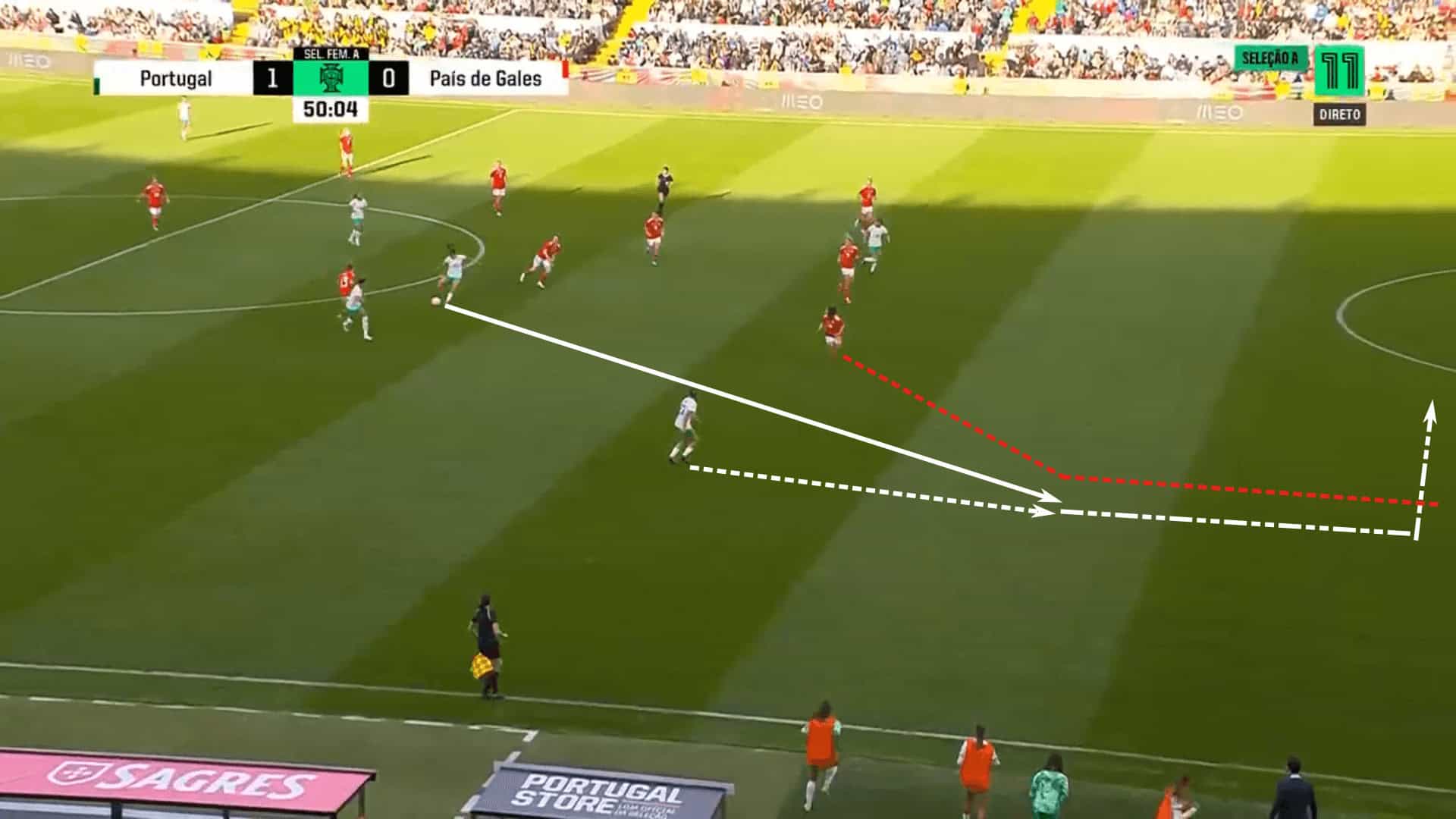
What was once the weak point of the team is now a strength. This is a very clever attacking team with the ability to attack opponents in many ways. Whether building out of the back and systematically connecting the lines to enter the final third together or playing more directly, especially with runs behind the backline, this is a side that should score goals at the World Cup, even against the likes of the USA and the Netherlands.
Defensive phase
Portugal’s defensive tactics were arguably their strength going into last year’s euros. In the end, they shipped 10 goals in the tournament, including a 5-0 drubbing at the hands of Sweden in the final group stage game.
Since then, Portugal have returned to their more resolute defending. Since last year’s Euros, they have played 10 games and conceded just seven goals. Of those seven, two came in the UEFA World Cup qualification playoffs, one against Cameroon in the inter-confederation playoffs, two against Japan back in April and the final one against Wales. The only other goal to mention was the one at Serbia back in September, the team Portugal were in direct competition with for second place in the group. Against stronger teams, Portugal are likely to concede at least one goal.
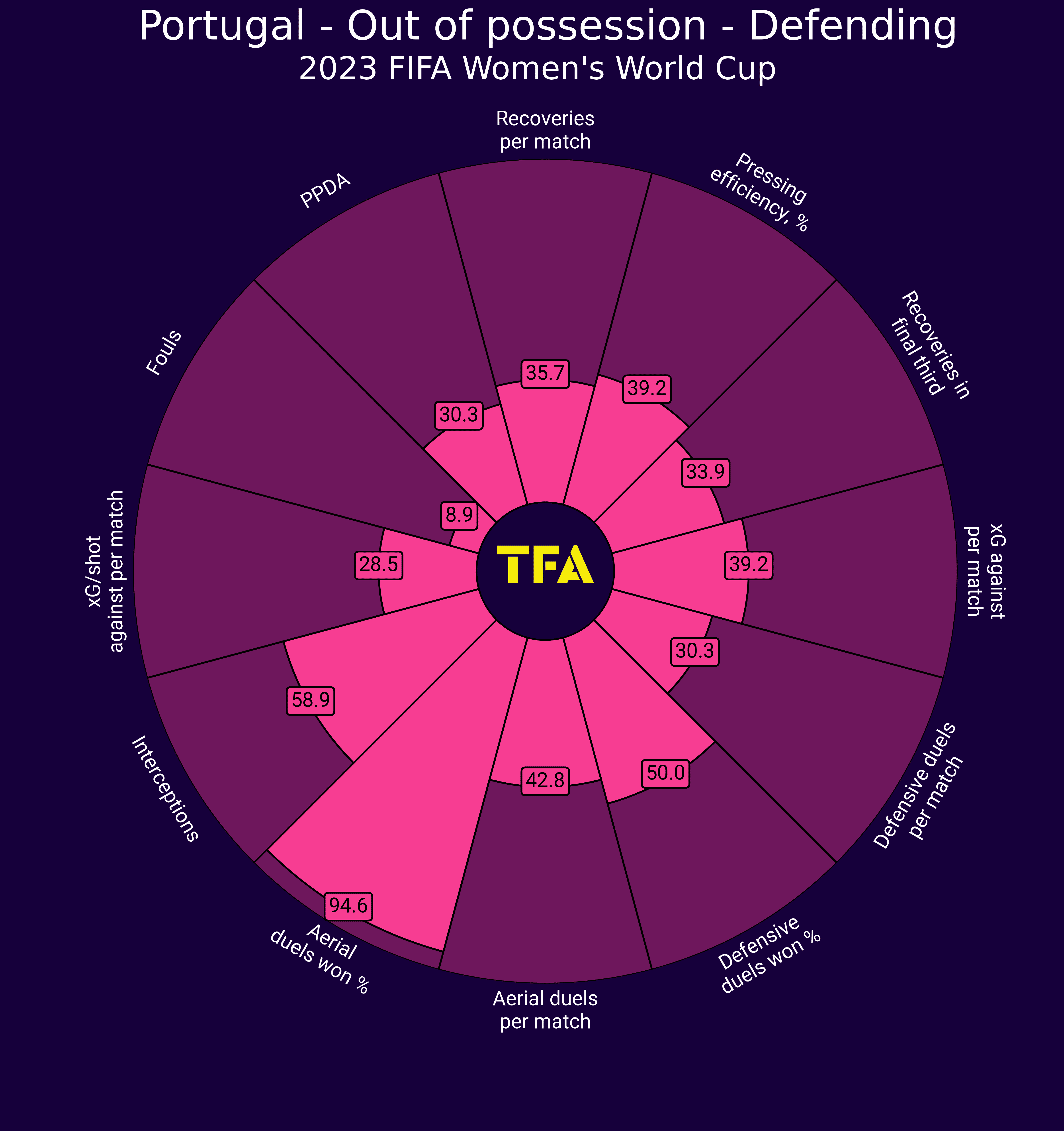
Given the quality of their group, Portugal will have to carry over their strong defending from the previous calendar year. Structurally, they will press within their system. If playing a 4-4-2, that is the way they’ll set up to press. The same is the case for the 4-3-3. Each setup is designed specifically for the opponent rather than an outright set of tactics.
Portugal will engage in the high press if there’s an opportunity but they are certainly more of a mid-block team. At last year’s Euros against the Netherlands, they seemed reluctant to move beyond a 3/4 press to protect the space behind the backline. As seen in the first tactical image of the section, the two forwards were responsible for the two Dutch centre-backs, effectively shadow-marking passing lanes into midfield. The objective was to keep them out of the centre of the pitch. The midfield supported the forwards’ efforts by remaining tight on the deep-dropping Dutch midfielders.
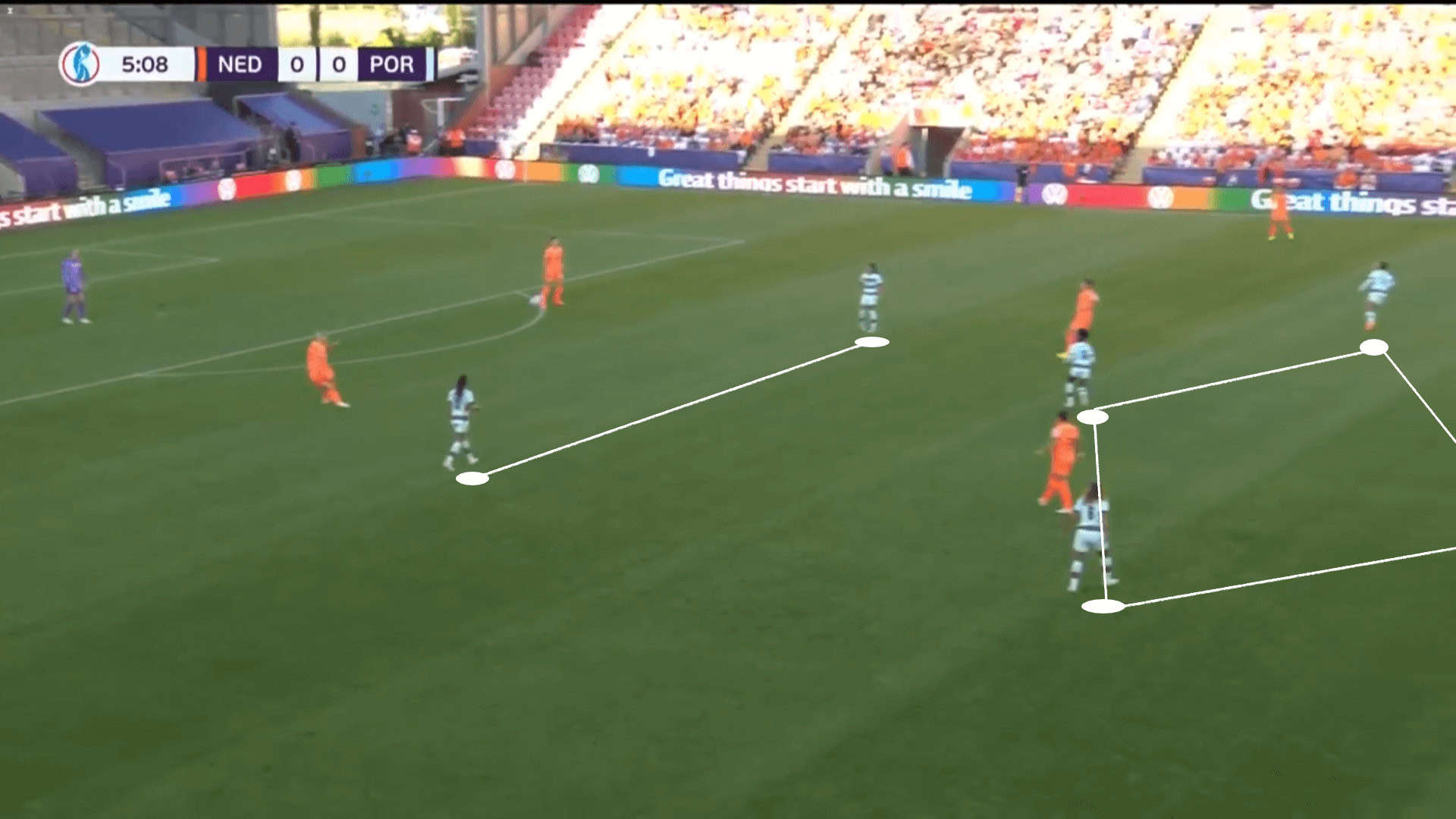
As Portugal shift into their mid-block, they are highly adaptable. If in a 4-4-2, they can take either a diamond or square approach in midfield. Ultimately, Portugal’s tactics will depend on what the opposition show. Against Wales, a side that didn’t emphasise the centre of the pitch, Portugal used the two box-to-box midfielders to help centrally while also making them responsible for the movements of the Welsh outside-backs.
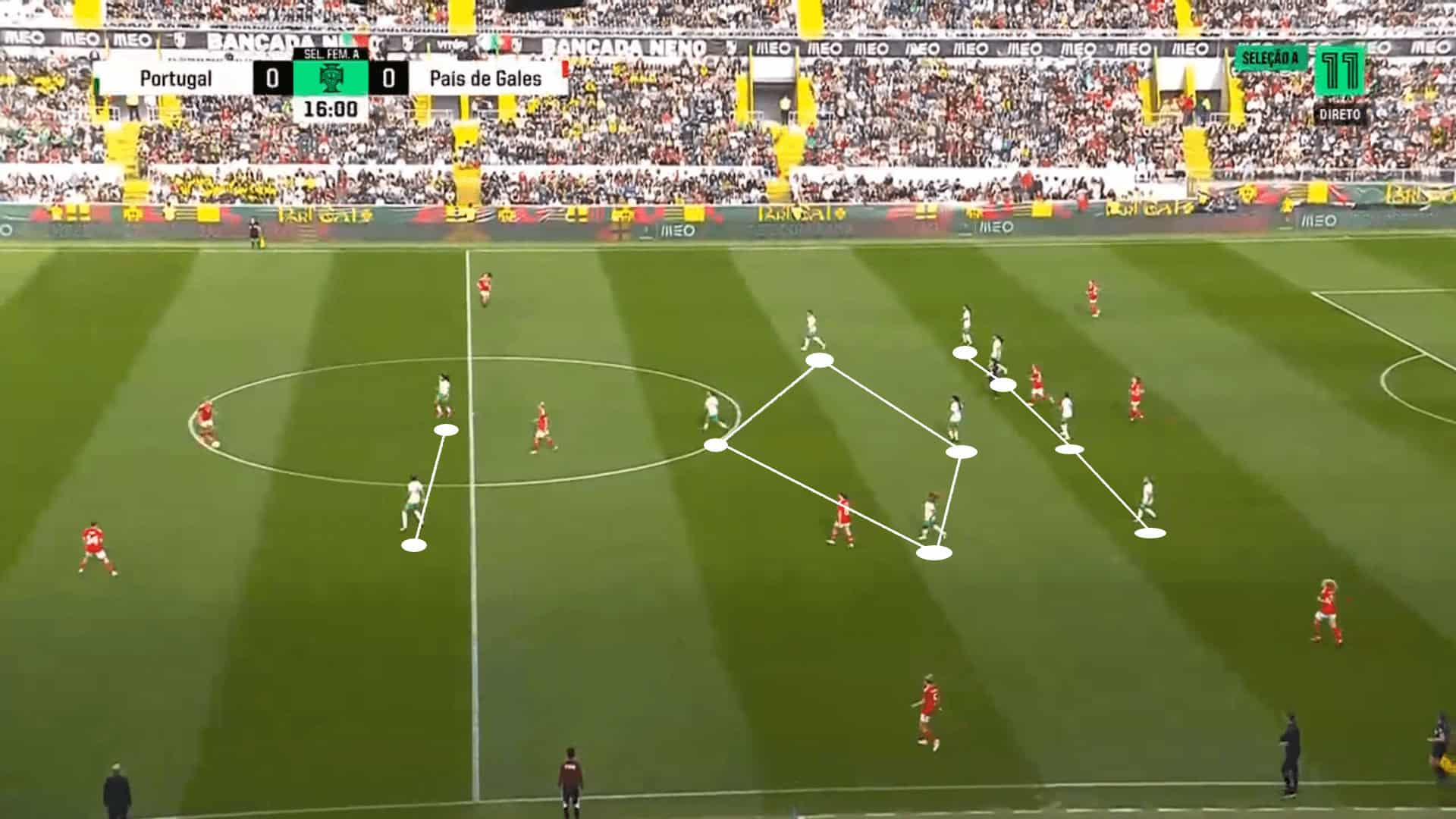
Against a Japanese squad that was more effective in possession, Portugal often used a box midfield. In the first image against Japan, we do see the immediate network near the ball, but also notice the far-sided overload. The Japanese have a clear intention of playing into the far-sided numeric superiority. Moving into a box midfield gave Portugal three players on that side of the pitch to deal with the looming threat while also covering themselves near the ball.
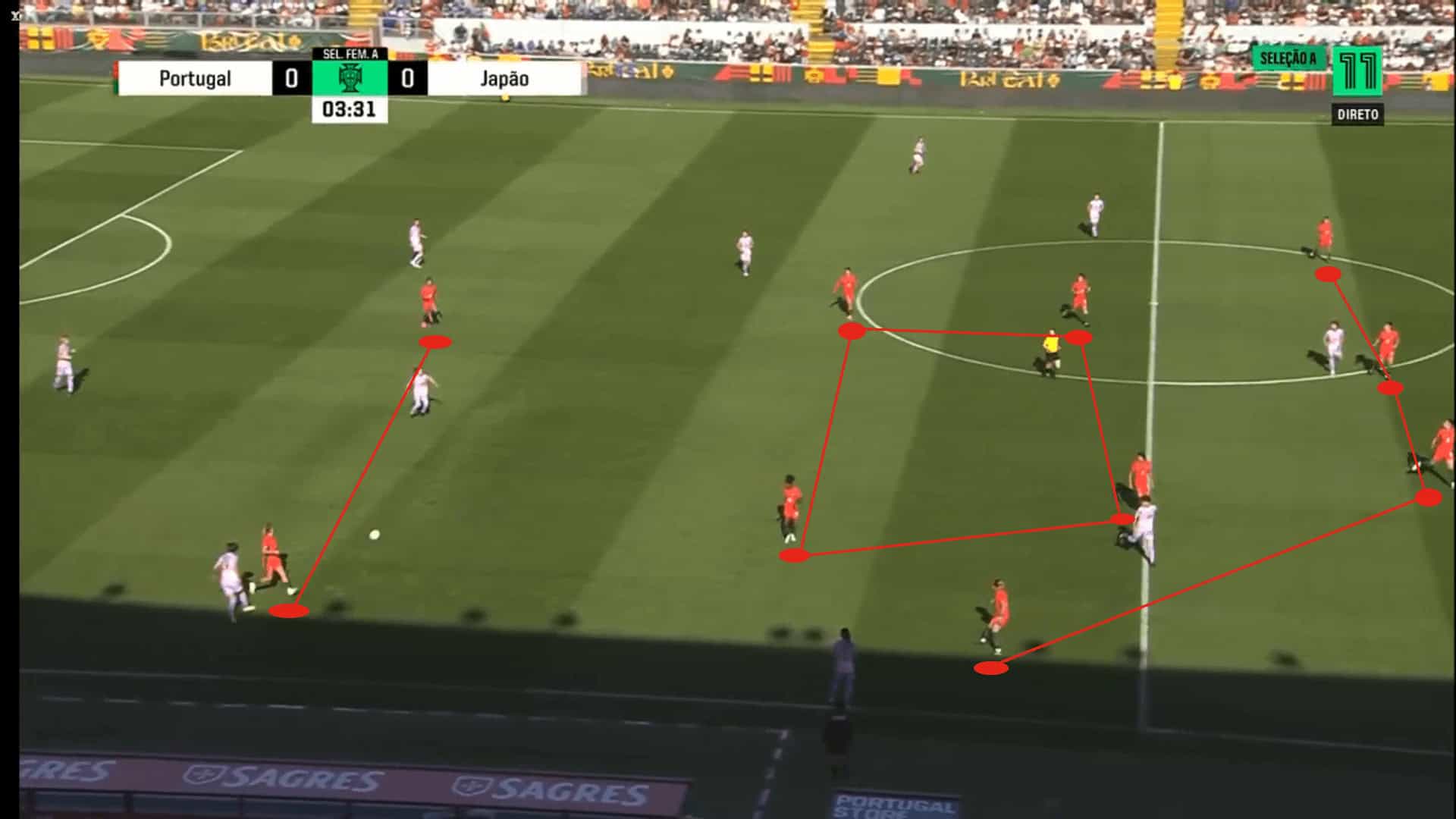
The objective is to engage the opponent from the mid-block with limited space to defend behind them. When the opponent pushes into Portugal’s attacking third, their shape shifts to a 4-4-1-1. The priority is getting numbers behind the ball, especially those first two lines. They want to defend the box with at least eight players while keeping short and long outlets further up the pitch.
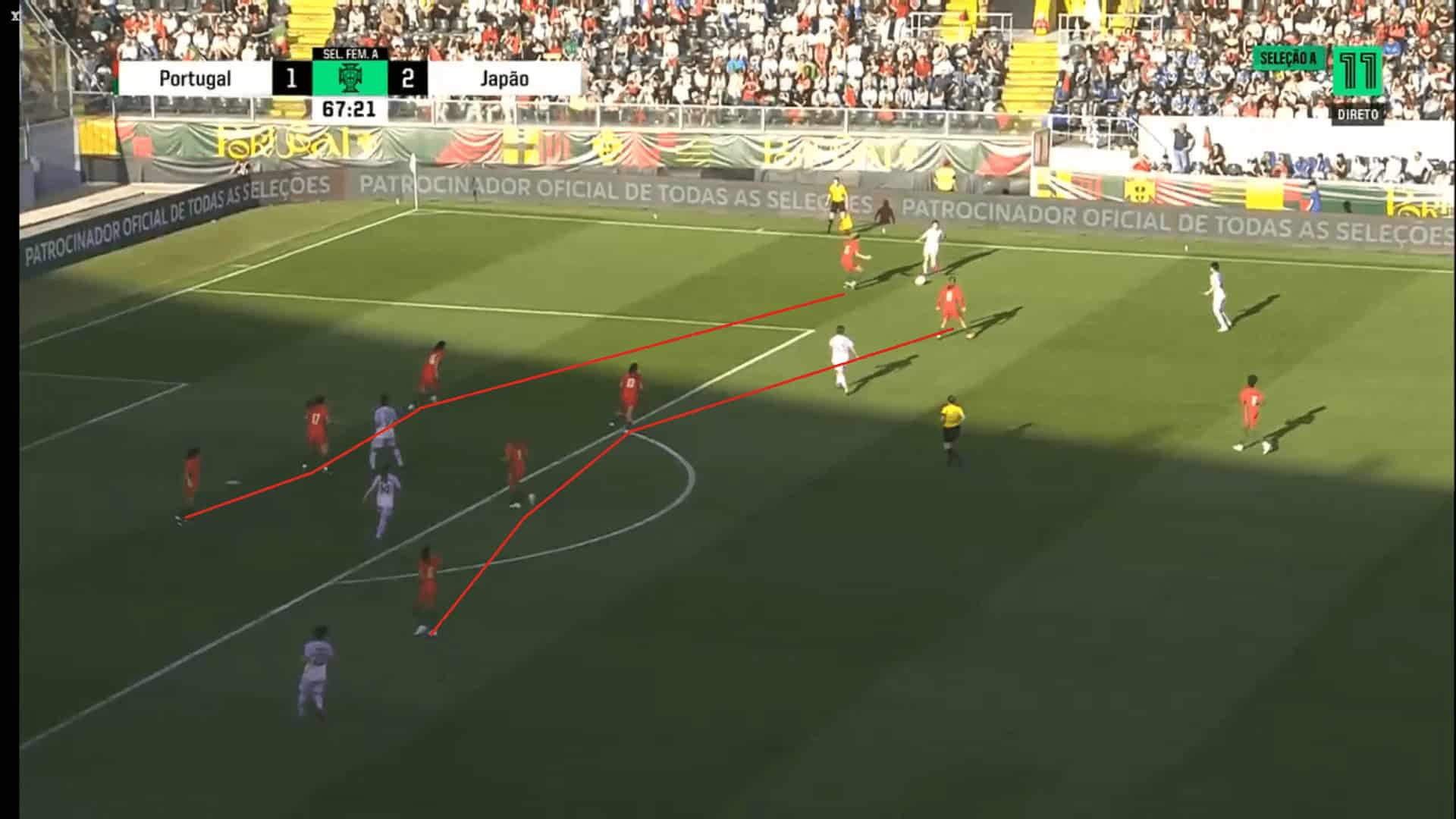
If Portugal are to shock either the USA or the Netherlands, they’ll need top-notch defensive performances. Goalscoring opportunities will be limited, so keeping the match close by limiting mistakes out of the back and scoring chances for those two powerhouses will be critical. Costa will be especially important in keeping her teammates organized. The team will lean on her experience in leadership at the back.
One final note for the section is that Portugal have shown they’re susceptible on set-pieces. That’s how the Netherlands claimed their 3-2 victory over Portugal. The first two Dutch goals came from corner kicks before Daniëlle van de Donk’s brilliant goal in the 62nd minute sealed the victory. Against two strong set-piece teams in the Netherlands and the USA, Neto’s side must be better prepared to deal with dead ball situations.
Transitions
Moving on to an analysis of transitional moments, Portugal will feel good about this phase of the game. Their strong rest defence and positional discipline will serve them well defensively. They’re very organised in and out of possession, so opponents should not expect many opportunities on the counter-attack. Portugal is fairly conservative with their use of the outside-backs going forward, so the backline should have at least three players back to help defend against counterattacks, as well as potentially a midfield four to either slow transitional moments or end them with fouls.
From a defensive standpoint, Portugal’s strong rest defence is shown in our first image. The centre-backs have taken up good position centrally, the outside-backs haven’t ventured too far forward to leave them disconnected and the midfielders are close enough to counter-press Wales. Between the containment of Gomes and the hustle of Fátima Pinto to recover, the Welsh were left with little time to get numbers forward in support of the first attacker. The result was an interception of an attempted through ball. It was an excellent counter-press from the Portuguese.
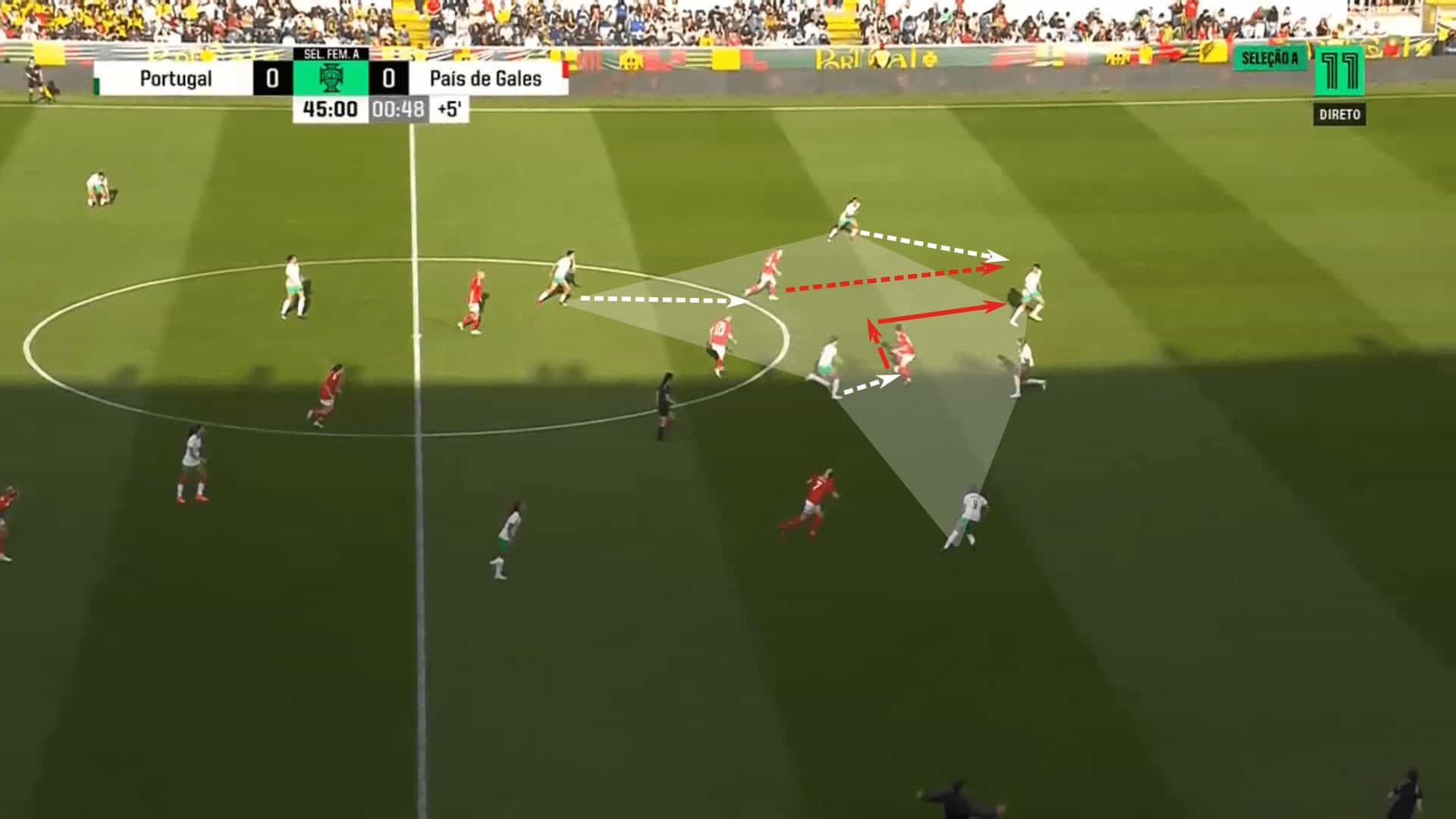
In their counterattacking, the Portuguese show a similar type of versatility that we see in open possessions. There’s a good blend of breaking lines immediately and knowing when to simply play locally to break the first wave of pressure.
We’ve picked out two examples to show Portugal’s versatility. First, upon recovering the ball against Wales, the Portuguese front line found heavy pressure on their backs. They made the good decision to set the ball into midfield, which cued the right-back, Catarina Amado to spring forward to offer an attack through the right-wing. It was a well-orchestrated move with cooperation between all three lines.
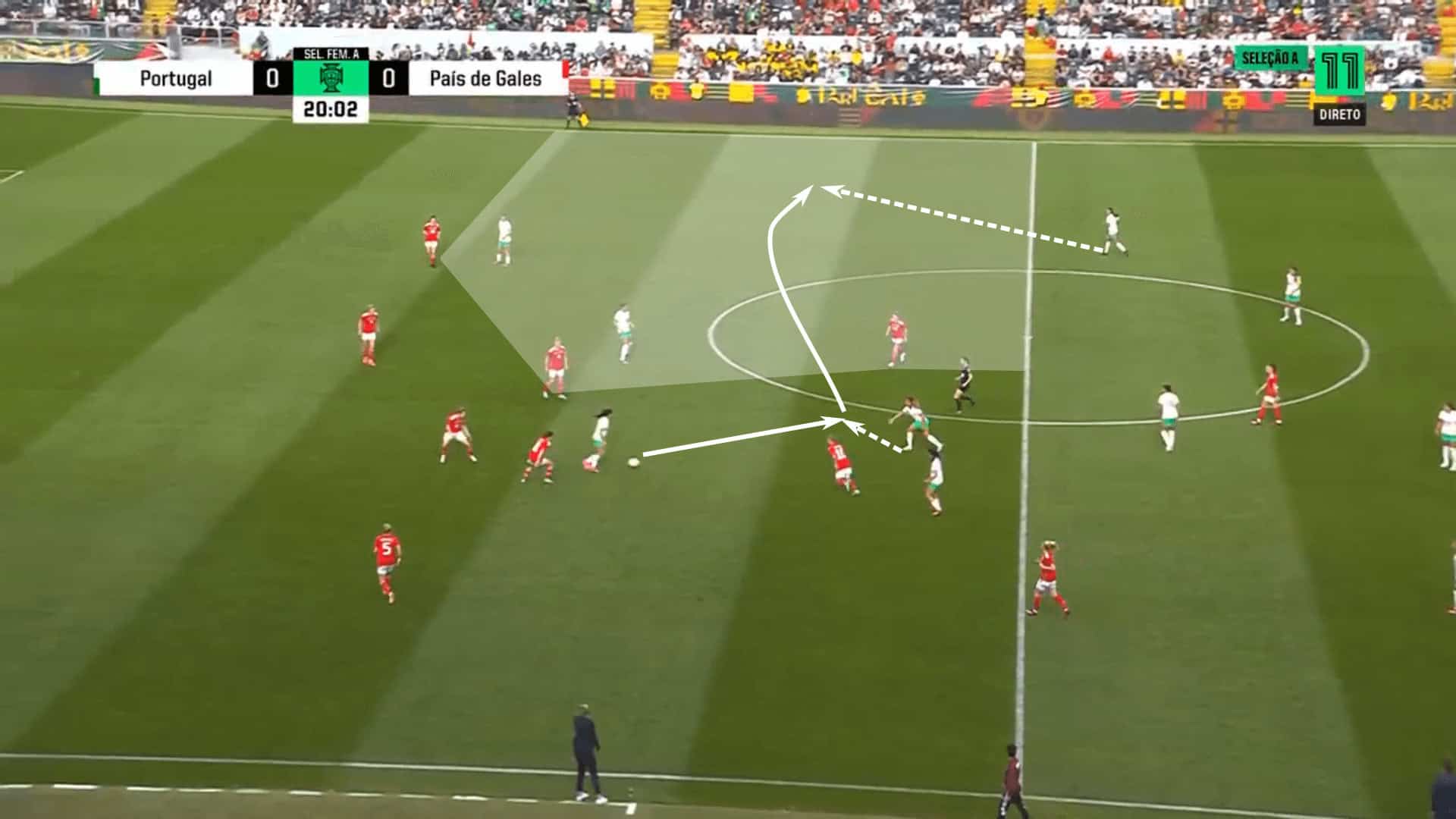
The second pattern is through more direct play. In this scenario, it was Patrícia Morais playing the ball behind the Welsh backline onto the run of Telma Encarnação. The forward ran clear of her mark and into the box. Her final touch slowed her down, allowing her opponent to catch her and block the shot, but it was certainly an opportunity for the Portuguese, one they should have capitalised on.

Though it is a simple ball over the top, one of the reasons for success is Portugal’s high attacking presence. Three players are positioned against the three deepest Welsh defenders. Any slip-up by the opposition is potentially fatal. Those three also have support underneath, allowing Portugal to contend for second balls.
Once they know that the deeper players will win the ball and kickstart a counterattack, the highest players in the formation show an understanding that they can push into higher positions in an attempt to stretch the pitch and take a more direct route to goal. Again, they are a side that will mix it up, not relying on one or two specific patterns forward. That adaptability to play within the present context of the game is a massive strength for the Portuguese. They’ll have to leverage it at the World Cup.
Attackers
Portugal brings a nice blend of youth and experience to the World Cup. Jéssica Silva and Diana Silva are the likeliest to lead the forward line, especially if Neto opts for a 4-4-2. Jéssica’s move to Benfica was much needed. In her first season back, she scored 17 goals in 17 games. Diana has also made a happy return to Lisbon, representing Sporting CP for the past two seasons. After a forgettable year at Aston Villa, she has produced 26 goals and 30 games for the Verde e Brancos.
Carolina Mendes offers experience off the bench and heads to the World Cup as the squad’s leading goal-scorer at the international level. Now at Braga, she offers a 1.72 m presence in the box when a late goal is needed.
Ana Capeta and Telma Encarnação can play up top or even shift to midfield. Capeta is especially good at late runs into the box while Encarnação is an all-around attacking player for her club side Marítimo. Borges and Nazareth may also mix in with the forward line. Borges would play out wide, likely on the left, while Nazareth would play more as a second forward.
Midfielders
Portugal brings a versatile midfield to the World Cup. Dolores Silva is a fixture in the midfield as the deepest midfielder and Tatiana Pinto has shown herself to be an excellent partner on the right-hand side in a box-to-box role. Norton is an incredibly skilful player who plays box-to-box as the left-centre mid. In a four midfielders system, Nazareth is likeliest to play the 10. She adds value in possession, but she’s extremely valuable making late runs into the box to finish off plays. Portugal will need her quality movement off the ball this World Cup.
Fátima Pinto is the first player off the bench if Dolores Silva needs the sub or Portugal wants to go more defensive. Ana Rute is more of a box-to-box player and the final piece to the puzzle is Andreia Jacinto, another box-to-box midfielder with excellent passing range who’s currently playing for Real Sociedad.
Defenders
Defensively, it’s the Benfica centre-back, Carole Costa, who leads the group. Heading into the pre-World Cup friendlies, she brings 153 caps to this side, surpassed only by Borges of Sporting CP. Borges will play to Costa’s left as the ‘part-time outside-back, part-time forward’ will likely take on a deeper role for the national team. Expect Diana Gomes to play beside Costa and Joana Marchão opposite Borges.
Lúcia Alves takes her spot on the team as the top backup at left-back while Catarina Amado is the reserve player on the right. At centre-back, it’s Costa’s teammate at Benfica, Sílvia Rebelo, who is the secondary option. The 34-year-old has 123 caps for the national team.
We’ll mention the goalkeepers here as well. Patrícia Morais of Braga should serve as the starter while Inês Pereira is the top backup. Rute Costa rounds out the goalkeeping group as the Benfica goalie will serve as the third-string keeper.
Key player
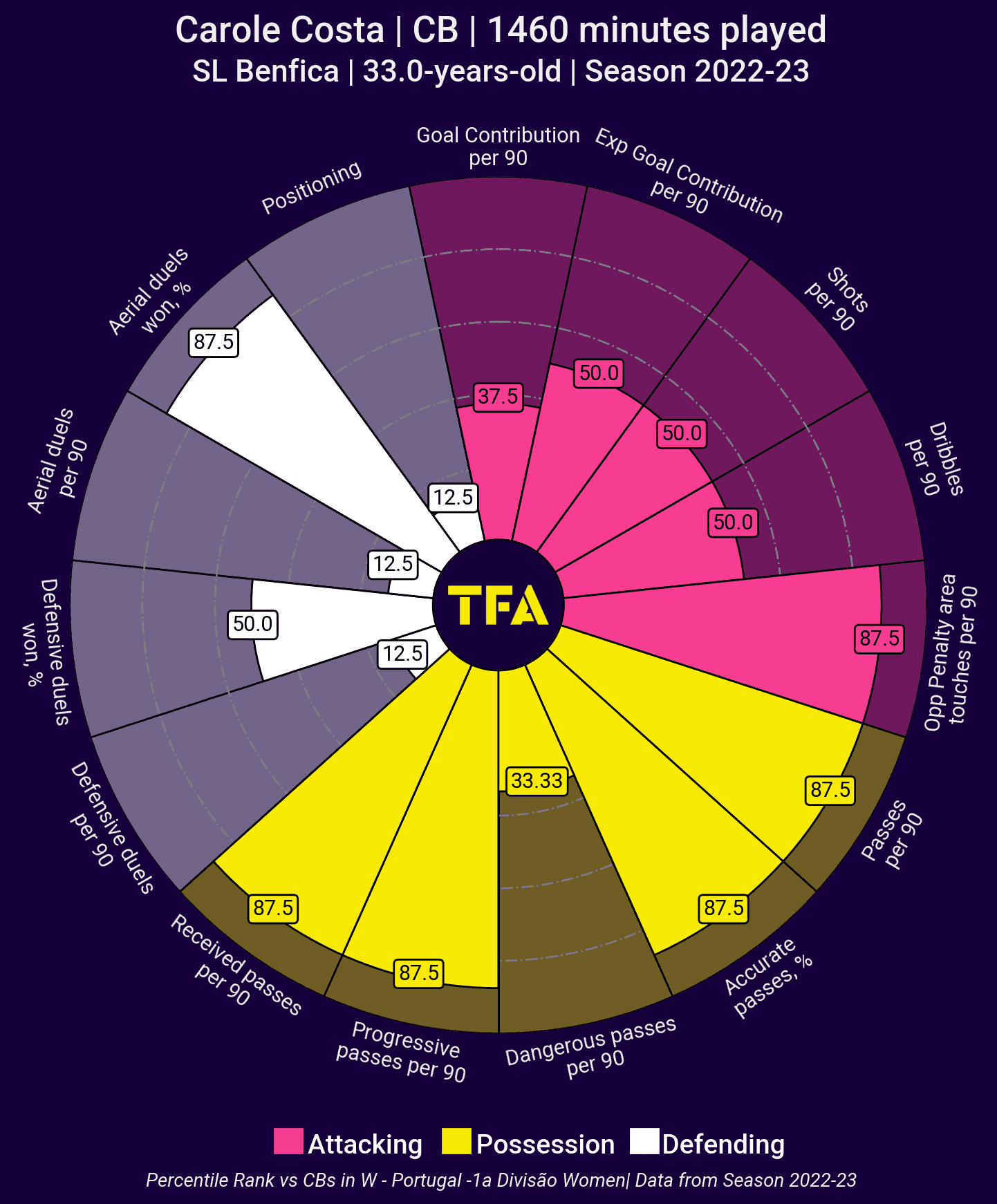
Portugal’s World Cup starts with a pivotal game against the Netherlands, will play Vietnam in game two, and then face the back-to-back champion USA in the final group stage game. A win against Vietnam is a must if Portugal are to survive the group, but they’ll also need at least a point from one of the other two matches.
That’s where Costa comes in.
Portugal will rely heavily on the leadership of their centre-back. The 33-year-old is the critical player in this squad on both sides of the ball. In possession, she helps track the build-out and uses her excellent passing range to get beyond the first lines of the opposition’s press. She’s also one of the team’s better set-piece targets.
Out of possession, she must exercise her leadership to keep the team organised. Though she doesn’t engage in many duels, one of her key strengths is keeping those around her organised. That preventative action more than accounts for the subpar defensive metrics, especially given that she plays for the top club team in Portugal, a Benfica side that has 13 consecutive League titles and only conceded seven goals in 22 games last season.
But the task is different with her country. Portugal will rely on her heavily to guard the likes of Alex Morgan and Lineth Beerensteyn. Portugal’s defence has to give them a chance in those two big games. Costa’s place in Neto’s tactics is pivotal.
Tournament prediction
Portugal are widely predicted to finish third in the group and it’s tough to disagree with that sentiment. The USA and the Netherlands enter the tournament as the first and ninth-ranked teams in the world and have a history of success in tournament play. Though most of Portugal’s squad also featured in the Euros, this is a different task. The USWNT and the Netherlands are excellent set-piece teams, which could be an issue for Portugal.
That said, Portugal gave the Netherlands a game two years ago at the Euros and the USA are missing Mallory Swanson and captain Becky Sauerbrunn due to injury. Portugal’s best chance of getting out of this group is with the surprise victory over the Netherlands in the first game and a second against a Vietnam side that should pose a difficult test in game two. Getting to the third game with six points in hand is a massive challenge, but it’s likely what the Portuguese will need to progress.
For a first World Cup appearance, finishing third in the group and putting in strong performances against the USA and the Netherlands would be extremely positive for Neto’s side.
Whatever the result, this historic moment is simply the second step in the evolution of the Portuguese women’s national team. With a strong core and quality young women rising through the ranks, they’ve quickly made up the gap with the top nations in the world.
Don’t sleep on this ambitious Portuguese team. More importantly, make a point to watch a game and enjoy their attacking flair.

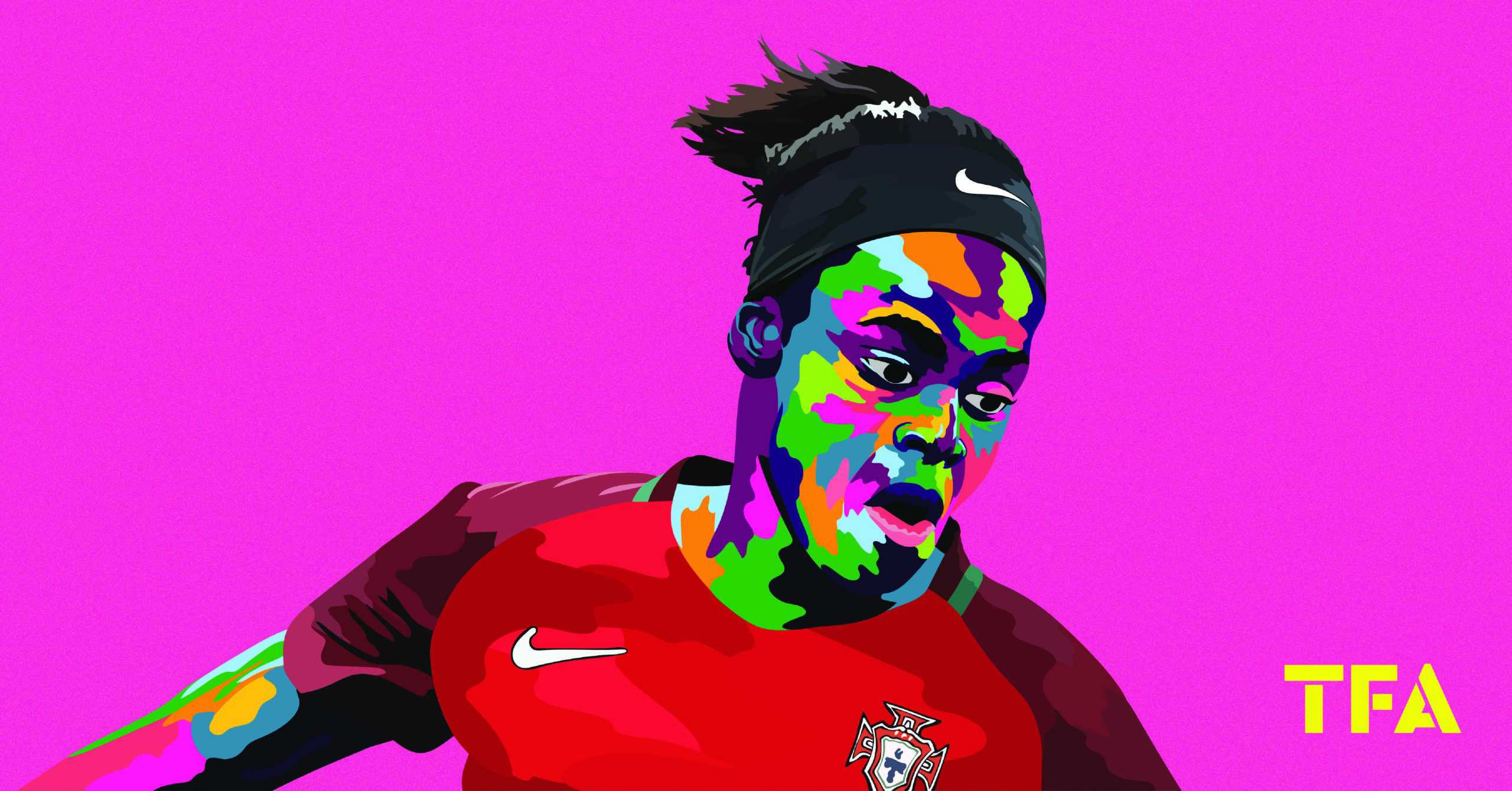



Comments